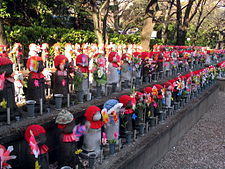Mizuko kuyō

Mizuko kuyō (水子供養) or "fetus memorial service", is a Japanese ceremony for those who have had a miscarriage, stillbirth, or abortion. This practice has become particularly visible since the 1970s with the creation of shrines devoted solely to this ritual. Reasons for the performance of these rites can include parental grief, desire to comfort the soul of the fetus, or even fear of retribution from the vengeful spirit.
Mizuko
Mizuko (水子), literally "water child", is a Japanese term for a dead fetus or, archaically, a dead baby or infant. Previously read suiji, the Sino-Japanese on'yomi reading of the same characters, the term was originally a kaimyō (posthumous name) given after death.[1] The mizuko kuyō ceremony was used to make offerings to Jizō, a bodhisattva who is believed to protect children. In the Edo period, when famine sometimes led the poverty-stricken to infanticide and abortion, the practice was adapted to cover these situations as well.
Today, the practice of mizuko kuyō continues in Japan, although it is unclear whether it is a historically authentic Buddhist practice. Specifics of the ceremony vary from temple to temple, school to school, and individual to individual. It is common for temples to offer Jizō statues for a fee, which are then dressed in red bibs and caps, and displayed in the temple yard. American religious scholars have criticized the temples for allegedly abusing the Japanese belief that the spirits of the dead retaliate for their mistreatment, but other scholars believe the temples are only answering the needs of the people.[2][3]
See also
References
- ^ 安斎育郎 『霊はあるか』 (講談社 2002年9月20日)
- ^ Page Brookes, Anne. (1981). Mizuko kuyō and Japanese Buddhism.. Japanese Journal of Religious Studies, 8 (3-4), 119–47. Retrieved 2006-04-02.
- ^ Martin, Elaine. (1996). Rethinking the Practice of Mizuko Kuyo in Contemporary Japan: Interviews with Practitioners at a Buddhist Temple in Tokyo. Retrieved 2006-04-03.
Further reading
- Jeff Wilson, Mourning the unborn dead : a Buddhist ritual comes to America, (Oxford: Oxford University Press, 2008), ISBN 978-0-19-537193-2
